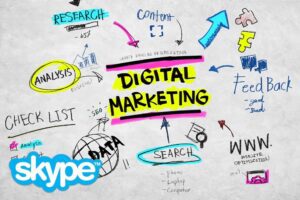IMC27: Social Media Roundtable
Ben is joined by Jack McCaughtrie (Core Tree) and Clare Harris to discuss the current state of social as well as tips and advice.
Notes
Social Media Round Table
- We look at social media accounts by activity
- Has social media use changed during 2020 lockdown? Has it brought us together?
- What kind of content works best?
- Does it pay to create personalised content and making the effort?
- Does social media work for customer service?
- How can I get more followers on social media?
Commit to action
What one action will you achieve over the next 30 days?
Need some Marketing help?
-
 Write the copy for your website£120.00 – £2,400.00
Write the copy for your website£120.00 – £2,400.00 -
 Write an engaging blog article£145.00 – £290.00
Write an engaging blog article£145.00 – £290.00 -
 Setup Google Shopping Ads£520.00 ex VAT
Setup Google Shopping Ads£520.00 ex VAT -
 Setup a standard Google Ad£390.00 ex VAT
Setup a standard Google Ad£390.00 ex VAT -
 Proofreading Service for Word Docs, PDFs or PowerPoint files£35.00 – £175.00
Proofreading Service for Word Docs, PDFs or PowerPoint files£35.00 – £175.00 -
 Half day Social Media workshop£520.00 ex VAT
Half day Social Media workshop£520.00 ex VAT -
 Half day Google Analytics workshop£520.00 ex VAT
Half day Google Analytics workshop£520.00 ex VAT -
 Digital marketing support call£130.00 ex VAT
Digital marketing support call£130.00 ex VAT
IMC25: WooCommerce walkthrough
Everything from setting up the plugin to products, discount vouchers and shipping and order processing.
Notes
Woocommerce is a full featured ecommerce system which allows you to sell a wide variety of physical products and digital products along with a wide range of extenstions for subscriptions and mentions amongst other things.
When you install Woocommerce for the first time
You need to access the Plugin tab on the dashboard at the back end of your wordpress website. Add new, then search for ‘Woocommerce’. It should be the top hit, press install now button and then activate to install.
Once it is installed you will get a little Wizard setup screen, going through some of the basic information.
Example site: https://ratherinventive.com/shop/
WooCommerce Key Tax Setup Tips
- Choose whether prices will be inclusive of VAT or not. Only shows it you enable taxes in General tab
- Chose whethere your customer base is business to business or business to consumer on which tax option you opt for.
- Calculate your tax based on your address. If your company is based within the UK, regardless of where the customer is located they will pay UK tax. There are lots of options available if you ship abroad and can rank your tax to correlate with different states and regions.
WooCommerce Key Shipping Setup Tips
- Shipping zones allow different options for each country or area you define
If you have any specific shipping issues, that I haven’t covered within the run through best to get in touch and run through these as shipping options are bespoke and taylored to each business differently.
Example site: https://campagnacollections.com/furniture/ where they have lots of different items and ship to different locations.
WordPress Payment
- By default Woocommerce comes with default payment details i.e Bank Transfer, Cheques, Cash on Delivery or Paypal.
- With each option you will follow the form to input your information and requirements.
- When setting up Paypal payments you will need to put in some details to activate this option. Ensure you capture the identity token so you can capture the payment and send the order details back to your website.
- We recommend Stripe highly for taking credits. You will need to add this as a plugin. It is free, there are lots of other free plugins for different payments method if you would like to chose something else.
Other payment providers: https://woocommerce.com/product-category/woocommerce-extensions/payment-gateways/
WordPress Privacy
- Options available that allow you to give access for guest orders or enforce customers to have an account to process the order.
- Information here to allow ppl to remove their data correctly through the woocommerce system.
WordPress Emails
- Get creative and customise your email communications that get shown to people
- Run through the settings to customise the look of your email
- Include company logo from your media library
- By default, the email settings are quite basic. There are other ways of customising that in code or find plugins to allow you to customise emails.
Products
- Highly recommend categorising your products so you are able to show targeted products on particular web pages of your site.
- You can also add thumbails for each category
- By default it will show related products in the same category but it possible to create upsell / cross sell items
Coupons
- Setup a Coupon under the Woocommerce menu tab
- Click Add Coupon which will allow you incentivise your customers by adding a discount off the final basket value.
- You have the option of percentage discount or fixed price discounts
- You are able to tailor the coupon to specific emails or products, limit the amount of time it can be used, set an expiry date etc
Processing orders
- Admin and customers get order emails (processed)
- Back payments will be put on hold until it is processed
- Once shipped or finished, orders will be marked as completed. Customer will get a final email to confirm the order
- In this page you can also refund orders from this screen
IMC22: Create an Google Ad walkthrough
This webinar is a screen share walkthrough of how to create text ad on Google. I share some of the tips I’ve learned along the way and my process for planning and creating ads on Google.
Notes
Where possible try to do inbound marketing put information out there for people to find. However, advertising and outbound marketing can help kick things off to start with. It can be good to combine the two.
Inbound – You put out information i.e. a how to guide, a video, give and share information. Your customer will find it online and share it for you.
Outbound – Pushing information at your customer; disrupting what they are doing i.e. a phone call, advert.
Planning
Advertising comes down to planning:
- Goal – What do you want to happen?
- Audience – Who is it for? What are their needs?
- Benefits – Why does your product matter?
- Budget – Guess at first, quickly learn acquisition costs (£ ads / # orders)
Review and monitor your adverts regularly.
We’ll be using CCTV Logbook from Ecl-ips as an example. This web app helps people audit their CCTV system hardware.
Campaign 1
- Goal: Signup for a trial walkthrough webinar
- Audience: Security Managers who need to know when assets where maintained as they are responsible for site security and cannot have any cameras or recording
equipment out of order. Saving time for staff or external engineers - Benefits: Detailed CCTV camera asset log, Maintains full audit history, Easy to use, Save time on engineering audits
- Budget: £600/mo (£20/day)
Campaign 2
- Goal: Watch video ‘How to manage GDPR and privacy for CCTV’
- Audience: Business Owners who need to comply with legal obligations of data protection enforced by ICO. Don’t want to risk fine.
- Benefits: GCPR compliant and secure. Reduce risk of fine from ICO
- Budget: £300/mo (£10/day)
Recommend video IMC11 Understanding your customer
Research
Quick research
- Search keyword in Google, note the main phrases used
- Scroll to bottom and look at related searches
- Build phrase lists for each campaign
Detailed research
- Tools / Keyword Planner
- Discover new keywords
- Add keywords from campaign phrase list
- Find more keywords, look for ones with higher searches and low competition
- If low search volume then might need broader range of keywords
- Check out the competition, what other ads/organic results are there? What are they offering?
Create keyword list
cctv logbook, cctv audit, cctv audit template, cctv audit report, cctv camera inspection checklist, cctv asset manager, cctv maintenance report, cctv audit system, audit software, cctv audit software
Split into two ad campaigns
CCTV Log Book
cctv logbook, cctv log book
CCTV Audit Template (or CCTV Audit Checklist log)cctv audit, cctv audit template, cctv audit report, cctv camera inspection checklist, cctv asset manager, cctv maintenance report, cctv audit system, audit software, cctv audit software
Forecast the cost
- Tools / Keyword Planner
- Get search volume and forecasts
- Experiment with different initial click costs
- Use to explore price to per per click
Creating a new campaign
- New campaign / Leads / Search / Website visits
- Website: https://cctvlogbook.com/
- Add main keyword to campaign name: cctv logbook
- Don’t include display partners. Dilutes traffic
- Expand more settings
- Add end date. To prevent leaving active. 30 days to start.
- Add schedule to run between 07:00-22:00. Separate for week day and week ends to make easier to review and disable
- Target to location. UK in this case as low searches but may wish to target locally
- Add a budget: £20
- And focus on conversions
- Add site links, extra links to specific pages
- Add call extension if relevant
Setup ad group
- Name as primary keyword
- Add keywords. BMM, Phrase and Exact. Allows easier review later
+cctv +logbook+cctv +log +book”cctv logbook””cctv log book”[cctv logbook][cctv log book]
Create ads
- Start with Google defaults and amend
- Create multiple adds with different wording. You can review and pause.
Google Ads Walkthrough Tips
- Never use broad keywords. This will waste your budget
- Analyse best keywords to use in tool like Google Keyword planner
- Search main keywords in Google to make sure expected results are returned and the keywords mean the same to you and Google
- Look at competitor adverts. Find out who is number one
- Limit number of ad group keywords to five and keep to same topic
- Use exact match [my keyword], phrase match “my keyword” and Broad Match Modified (BMM) +my
- +keyword to capture broadest range of traffic and help review process
- Use bid stacking e.g. Pay more for exact match (most expensive), phrase match (next), then BMM (next)
- Check devices: and change bid adj if want to exclude device types such as mobile
- Setup ad schedule 7am-10pm for general viewing and removing time waster clicks
- Ideally link to dedicated landing pages on website with text that mirrors the ad
Swipe-Worthy – Marketing, Ad and Copywriting examples
IMC21: Mining LinkedIn to find prospects
Learn more about mining LinkedIn to find prospects and then how best to engage with them.To help me explore this topic I’ll be joined by social media and blog writer Jack McCaughtrie from (Core Tree).
Notes
Guest Jack McCaughtrie from Core Tree
Why mine Linkedin for prospects
- Remote networking
- Local, national or global reach
- Connect with difficult to reach individuals
- Build awareness of your company and how to help people
There is less noise in the channel, because it is a business to business platform it has a more professional mentality to it and people are more diligent in their approach
Jack McCaughtrie
Case Study – Witley Jones
Bespoke school furniture manufacturer, based in Worcestershire.
- They wanted to build their awareness and engagement in education
- Trying to get an in, in a busy market
- Approach of not hard selling but one of trying to support and align partnerships
Understand, Engage and Convert
Building an Audience
- Quality not quantity
- Reconnect with contacts, clients and colleagues
- Use market intelligence to identify new companies and people
- Connect with new people you have (or going to) meet
- Digitising your network
…you have 100% control who is in your audience and have control in targeting the right people. It is important you connect to the right kind of audience, a target client or prospect who have some value to you or you to them.
Jack McCaughtrie
Search
- Use Company Pages to find best contacts
- Search for Job Titles,
- Location and industry
- Set up ‘Search Alert’ for weekly email
Who to connect with
- Connect with people who are directly relevant to you
- Associated with markets you work with
- People who would be interested in content you can share
- People you can help with
- Don’t simply collect connections
- Connect with people that interact with your posts
Start a conversation
- Personalise your connection invitation
- Soft intro message once connected. Not sales focused
- Ask questions to encourage a response
- Follow 2/3 days after invite accepted
- Be patient
Breaking the ice
- Be inquisitive about their business or sector
- Make an opportunity to send more information – relevant blog or video
- Refer to a post they have shared recently or something you have seen on their website
- Ask a favour (Benjamin Franklin effect)
Nurture & Follow-up
- Sow the seeds that will grow over time
- Be patient. Building relationships take times
- Have regular content to share within your network
- Ask who the best person to contact
- Ask if you can share more information
- Don’t be afraid to follow up once, twice, three times
Review your profile
- Must be up to date and accurate
- First impression counts
- Make it relevant to your audience
- Answer the questions your new connections will have
- Add link to website and videos
- Consider the posts you share and engage with.
IMC20: Blog Content Consolidation
Ben is joined by guest Copywriter, Catherine Every (Hello Pippin) to discuss how to review your blog to find the best-performing articles and which ones need cutting away.
Notes
Guest Copywriter, Catherine Every (Hello Pippin)
What is a blog review and why do we do one?
- Remove thin content / consolidate articles
- Aim: to focuson content quality, improve search visibility, build traffic
Casestudy
Communion Architects www. communionarchitects.com
They have built up a lot of posts over 8 years some with good traffic but could be improved.
Collecting the data
- Collect data over a full two year period
- Export article pages from WordPress
- Marry up article pages, GA, GSC data into Google sheet Compare which pages most visited from search
- Find low performing pages and review
Blog Review
- Start with the low performers (<10 visits)
- Then tackle pages with >50 unique visits
- Make notes on pages actions to take
Review Process
- September 2019 and January 2020
- Review all posts, make notes
- Start with the easy stuff: delete or fix broken links, images
- Combine posts: Read, outline new content, collate, rewrite
- Review in a day or with Alex (client)
- Key challenges
Review Checklist
- Can content be deleted and redirected?
- Can content be merged with other articles?
- Should the article be split up and extended?
- Can URL, title be improved? Keywords added
- Can content be improved
- Is it in the correct category?
- Any missing images or broken links?
- Can any relevant images or videos be added?
- Does it have a link to a landing page?
- Are there any content gaps?
Tidying Up
- Site audit to make sure everything works
- All deleted posts are redirected to new ones
- All internal links point to new articles
- Note content ideas for future articles
- Be careful not to change URLs for key pages
IMC19: Architectural Photography
I’m joined by Jack Nelson (Photographer) to discuss why great photography is crucial to show your property in the best light.
Notes
The importance of great photography
- Why is it worth the time and money?
- Examples: Exterior Croome Court, Interior Croome Court & Heath Town
Get the lighting right
Examples: Kensington Palace & 3D Render image comparison
Staging
- Interior or exterior
- Make sure everything is neat and tidy
- Image examples: Airbnb Slide 17 & Airbnb Slide 18
- Light and bright
- Dark and Dull
- Trace of life
Video walkthrough
- Drone or Handheld
- Understand the layout and flow better than photos
- 3D Experiences
3D Experiences
Matter Port
- User lead, Immersive, Fun
- System to capture and display 3D Photography Visitors explore in their own time
- Ideal for estate agents, also great for holiday lets and shops
- Make your own Matterport 3D on iPhone
- Matterport demo on https://bengoughproperty.com
Augmented Reality (AR)
- Move freely within 3D space View products in situ
- Communion AR example and commentary video
- www.apple.com/augmented-reality/
IMC18: How to design and build a website
Ben shares his website design process from planning to going live as well as reviewing some of the most popular website platforms to chose from.
(more…)IMC17: Google Search Console (GSC) walkthrough
In this episode Ben talks you through how to use GSC (Google Search Console) to find your website Google rank and page errors.
Notes
What is Google Search Console (GSC)
Tool that shows data from Google Search Understand how people find you online What keywords get the most clicks Identify problems on your site
Setup and verify
- Domain or specific URL
- Example mydomain.com for Domain or https://mydomain.com for URL
- Prefer verifying with GA
Overview
At a glance look to make sure there are no issues
Performance
- Compare traffic you are getting with clicks
- Impressions are times snippet show in search results
- Clicks are when people clicked through to website
- Queries are the search terms people use
Identify traffic issues
- Filter on blogs
- View traffic to pages. Why lots of impressions but not many clicks
- Click URL to filter on specific URL and view queries
- View average position, are things headed in right direction
- View page snippet and page content, do they make sense
SERPS
- What search engine ranking position you are for certain keywords (Add new query)
- Add new query for ‘marketing club’
- Just started optimising. Starting to get impressions but lacking clicks
- View page snippet and page content, do they make sense
URL inspection
- Make sure a page is indexed and if not expedite indexing
- Adding or refreshing a sitemap can also force Google to index your site again sooner that it would otherwise
- Check snippets work
Coverage
- Start with errors first
- Next any pages that are blocked from index
- Email domain believed to be from client’s posting email link on website
- If issues fixed you can re-verify
Excluded pages
* Why are they indexed? Are they linked on your site?
* How to find links that appear on your website site:ratherinventive.com “email.ratherinventive.com”
* This year we changed over the site. Found lots of old URLs still in Google index and have setup redirects to new pages
* Yoast also had an issue where it made all image into pages
Sitemaps
- Add sitemaps to make sure google indexes all your pages
- Also helps highlight if there are pages in the sitemap aren’t indexed
- On WordPress Yoast SEO plugin makes sitemap Yoast > General > Features > XML Sitemaps (click question mark), then see the sitemap
Removals
- Useful if you must have a page removed from the index
- Temporary measure. Make sure the actual content has been removed, marked as 404 or no-indexed
Enhancements
- Mobile had an issues, fixed it and asked to ‘Validate Fix’
- Make sure no issues with bad or missing structured data
- Recommend listening to interview with Duene Forester on structure data and why you should use it https://ratherinventive.com/blog/duane-forrester-yexts-vp-industry-insights/
Manual Actions
Make sure there are no penalties against your site
Links & Settings
- Interesting to see what domains are linking to you
- Add other users. Only give full permission if they really need it
Connect Google Analytics (GA) to GSC
Allows you to view the search data and landing pages in GA
IMC16: Improve landing page SEO
Ben shares how to improve landing page SEO by optimising a specific page of your website to rank higher on Google.
Notes
Improve landing page SEO
Optimising a specific page of your website to rank higher on Google
What is On page SEO?
Work on your site to improve SERP (Search Engine Ranking Position)
All in your control (website platform dependant) Watch session #6 for general SEO Strategy.
Selmach Case Study
Sell high value metal working machinery a Competitor was starting to win business and their Laser landing page was not ranking in Google results.
The Method
Competitor Analysis | Make Changes to Page | Measure Result
Step 1: Competitor analysis
Compare the Competition’s SEO to our page Keyword Correlation Report and interpret the findings into action.
Process
- Group call – Client, SEO, Web dev
- Review the report – Needed interpreting
- Decide on easy wins
- Basecamp to assign actions
Observations
- Category Landing Page (LP) not in 100 SERPs
- Title tag not using optimised keyword
- Poor/few internal links
- No external links to landing page
- Increase word count to over 1400 per page
- Add keyword or variations into content more
- Use variety of content: Lists, images, tables
- Use schema markup
- Page not in index. Yoast issue
Step 2: Make Changes
- Made observation changes to the landing page.
- Add links from other pages.
- Create the ultimate guide
What we did
- Add keyword to heading: CNC Fibre Laser
- Optimise meta description. Not too long and include keywords
- Added product info, testimonials, FAQs, images, comparisons
- Add keyword variations into content
- Added FAQ schema markup
- Add links from related news articles back to LP
- Another review to check progress
Step 3: Measure & Tweak
- Measure SERP (Search Engine Ranking Position) Content update took one month
- After two months jumped to #3
- Then to #1 one month later
What is a Keyword correlation report?
Comparison of your page against competitor pages based on keywords you want to rank for.
On page SEO tips
- Title, Meta Description and Heading must include keyword
- Great the ultimate guide. 10x better than competitors
- Use variety of content such as headings, lists, images, tables
- Include keyword variations in the content
- Make sure all related blog, product and supporting pages link to LP
- Build external links from other websites to the LP
- Use FAQ and other schema markup
- Check in GSC that page is indexed!!!
Helpful Links
- Why Use Schema, Duane Forrester shares some helpful insights on a previous podcast interview.
- Mark up your FAQs with structured data
- Comprehensive website SEO report to improve your search position and ranking against competitors.
- Book your Super-Correlation Keyword SEO Report for focused optimisation on your landing pages
IMC15: How we make our podcast
Ben shares everything we do to create our Rather Inventive podcast, including lessons learnt, stats and helpful tools.
Notes
What is a podcast?
- On-demand radio show
- Daily, weekly, monthly
- In a series
- Generally audio only
- Over 550,000 on Apple Podcasts in more than 100 languages (June 2018)
- 49% people listen at home
- Podcast listeners are loyal and affluent
- 81% of people take action as a result of listening to a podcast
Sources
https://www.podcastinsights.com/podcast-statistics/
https://rainnews.com/spotify-shares-podcast-stats-and-advertising-examples/
Why did we start a podcast?
- Used to record radio shows on tape recorder
- Chatted with Al regularly, good to share
- Great opportunity to meet people
- Wanted to learn
If you’ve not subscribed to the podcast please do at https://ratherinventive.com/podcast/
- April 1st 2014 First show with Nick Van der Walle
- November 2018 – First video podcast
- December 2018 – Moved entire podcast to video
- October 2019 – Interview with Nick again!
- March 2020 – Latest podcast with a magician
Over 90 recordings!
Format
‘Two guys chatting’
Interview show
Reporter / NPR
One voice
Our process
Prep
Structure has evolved
Show notes
List out questions
Practice your start and ending
Script for Podcast running order (template)
Guests
It started with an interview
Interview people that inspire you or youraudiencee
Scheduling – Doodle, Calendly
Script for Inviting a guest onto your podcast/vlog (template)
Recording
Audacity, Quicktime
Zoom, Demio
iPhone (front and back cameras)
External microphone – reducing echo (I use Shure MV5)
Editing
We edit for audio consistency
Audio only – Fission, Quicktime, Audacity
Video – iMovie, Final Cut, Adobe Premier, Shotcut
Music – Intro, background music, Envato Elements (£13/mo, Free account 12 free files/month)
Publishing
Titles – Informative / funny
Graphics – Find the smile
YouTube (free), SoundCloud (£125/yr) / Libsyn (£52/yr)
Sharing
Share on Twitter and LinkedIn. I prefer LinkedIn
Better to share direct link to video/media or teaser clip
Tag in any guests. Share link by email
Sponsorship
How to ask. Pitch an idea Insert or live read Industry standard CPM £10-20
Charge what you think it is worth
Script for Asking for sponsorship (template)
Starting something newTakes a lot of effort and planning
Want to focus on RI, not just guests
Build up IMC
Marketing currently too diverse
Re-use current material
Need some Video help?
-
 Event video filming and production£380.00 – £885.00
Event video filming and production£380.00 – £885.00 -
 Edit your supplied video footage£70.00 – £1,300.00
Edit your supplied video footage£70.00 – £1,300.00 -
 Create video from a slideshow of images£50.00 – £190.00
Create video from a slideshow of images£50.00 – £190.00 -
 Client case study video filming and production£380.00 – £885.00
Client case study video filming and production£380.00 – £885.00
IMC14: How to make fab client testimonial videos
Learn why you should start asking for video testimonials. I share my tips on filming & editing including my recommendations on which software to use.
Notes
Why you should start asking for video testimonials
- Helping people make a decision
- Adding value
- Educating potential customer
Stats
- 92% of customers read online reviews before buying
- 70% of people trust reviews from strangers
- Customer reviews create 74% increase in product conversion.
- Videos trigger emotions. We mirror people
- Video has a higher retention rate compared to text Videos are easier to share
How to ask for a video testimonial
‘Can you do me a favour’
Opportunity for customers to get involved
View full list of email templates
Interview formats
Formal Interview
- Traditional / professional
- Interviewer behind camera or facing each other
- Considered response
- Take longer to organise and film
Quick ‘Vox Pop’
- Casual, more authentic
- Capture opinion and emotion
- Quick to film and request
- Risky for live broadcasts, if unplanned
Video Conference
- Easier to schedule, less travel
- People feel more comfortable in own environment
- Difficult to control audio/visual quality – Internet speed!
- Limited camera angles
Selfie
- Authentic / intimate
- Easy to request and schedule
- Mostly concise. Ask one question
- Rely on technical ability of customer
- Easier for people to say no. Incentivise?
Questions to ask
- Impart trust and proof of your service
- Get a testimonial
- Share something secret or a tip
Questions to ask
‘What’s your name and who do you work for’
‘What do you do and how do you/your company help people’
‘What’s one thing you do that people remark on or enjoy’
‘What one area have [insert company] helped you in your business’
‘If you were to recommend [insert company] to a friend or colleague, what would you say?’
Sample questions you can use for your own interviews
Tips for filming, editing and publishing great video
Filming. Audio first, then lighting
- Use external mic, close to mouth. Get rid of external noises. Soft room
- Outside or face a window. Turn on all lights. Not backlit
- Turn camera on early, avoid starting. Practice run
- Sit dow to relax and prevent moving in the shot. Table in front for protection Be positive and be relaxed. People will echo this
- Allow time, don’t rush. Remove distractions and pressure
Live or recorded?
- Shared immediately
- Cannot correct or fix
- Make sure to warm people up Record ‘as live’
Cut aways
- Filming extra footage ‘B roll’
- Buildings, products, people milling (soft focus)
- Get more than you think you need
- Use another camera for alternate angles
Editing. Story is key
- Jump cuts or hidden edits
- Make notes of good takes.
- Use mini whiteboard
- Start with the best interview clips
- Edit out dupes, cough, ems etc Remove waffle
Hiding edits
- Two camera angles
- Behind interviewee’s head
- Noddy shots of interviewer
- Cut away shots that relate to conversation
Publishing
- YouTube / Vimeo
- Create your own Thumbnail. Optimise for smiles
- Embed on blog post or client page
- Add mini text transcript to video or add to blog
- Title for SEO so people can find e.g. ‘Avigilon camera review’
The kit Ben uses
- iPhone 7. iPhone 11 has better cameras
- Shure MV5 mic. Tie clips would be better for formal interviews
- Clips on iPhone for quick social posts
- iMovie or Final cut for formal edits (macOS / iPhone)
- Manfrotto tripod.
- Joby iPhone mount
- Mini whiteboard (new idea)
Need some Video help?
-
 Event video filming and production£380.00 – £885.00
Event video filming and production£380.00 – £885.00 -
 Edit your supplied video footage£70.00 – £1,300.00
Edit your supplied video footage£70.00 – £1,300.00 -
 Create video from a slideshow of images£50.00 – £190.00
Create video from a slideshow of images£50.00 – £190.00 -
 Client case study video filming and production£380.00 – £885.00
Client case study video filming and production£380.00 – £885.00
IMC13: Productivity at work
Ben shares his thoughts on how to make better use of your time so that you feel more in control of your workload.
Notes
Productivity books / Concepts / Workflows etc
So much info out there but much of it is fluff
Getting Things Done (GTD)
- Ben’s first productivity book
- Capture actions in a trusted system
- Do the small things first
Capture everything
- Note down ideas, actions and thoughts in a trusted place.
- Use Apple Notes, small memo book
- Helps stop your mind racing
Process your inbox(s)
- Clear to zero – Paper inbox, capture system, email Do, Delegate, Delete – Don’t skip anything
- Process your inbox each day
- Set aside time in the calendar
Is it actionable?
Yes: Do, Delegate or Defer
No: Delete, Incubate, Reference
Weekly review
- Collect your thoughts
- Note down in trusted capture system
GTD Podcast
Really interesting podcast, even if you don’t do GTD https://gettingthingsdone.com/category/podcast-2/
Working with email
- Archive emails, don’t file them
- Search when you need them
- Use a clear subject line, so you can find it later
- Only include people that need to see it Filter email (if you can)
Default diary
- Block out regular time
- Share with your team / partner
Don’t let time be stolen from you
- Keep meetings short / request short meetings
- Turn off notifications
- Plan time for social media etc
Don’t write it twice
- Think like a lazy programmer
- Save time
- Reduce mistakes
No excuses
- Get on with it
- Take responsibility
- Just start
Be above the line. Accountability not Blame
Idea from ActionCoach
Helps to prevent procrastination
Exercise
30-60 minutes a day. Walking is fine
Get access to light
Get 7-8 hours sleep (or as much as you need)
Free audio books
Free copies of my fav
Audible books Ping me if you want me to gift you a copy
IMC12: Google My Business walkthrough
In this Google My Business walkthrough Ben covers everything from claiming your listing, setting the correct categories to optimising for SEO
Notes
Why use Google My Business (GMB)
- Only way to get into the local pack
- Small factor (<9%) in regular SEO
- Get a knowledge panel Collect reviews
- Control of your map listing – Anyone with a Google account could: suggest an edit, post photos, ask awkward questions
Screen-share of Google My businessCreating/claiming a listing
- Check in maps to see if listing already exists https://www.google.com/maps
- If not then start creating https://business.google.com/create
Getting your profile info order https://business.google.com/dashboard/l/11925252192446860058
- Title – Your company name plus keywords if they read well
- Categories – Help ranking. First category is the most important as visible on profile
- Location – Add address if customer come to you e.g. shop, office. Get the map pin right e.g. 7 Stirling Works, Love Ln, Cirencester GL7 1YG
- or Services areas (max 20) if you travel to customers
- Opening hours
- Special hours – eg xmas day
- Phone number – Could use a special number to track calls from listing
- Google Ads phone
- Shortname – Create a shortlink to your map page e.g. https://g.page/rather-inventive-marketing. Doesn’t work for all categories
- Links – Web, Appointment ?utm_source=google&utm_medium=local&utm_campaign=gmb_listing
- Highlights – Google will recommend ones you can add e.g Sink Green
- Description – Does not impact on rank, could help conversions. Show what you can do and how you help
Add Products / Services
- Recent updates to this as now split into categories, worth reviewing
- May have products instead (dependant on category)
Add Photos and videos
Photos
- Anything that showcases your business
- Identity – Business logo, cover image, etc
- Team – your team in action, around the office, etc
- If you category allows: 360, Inside and out of office or store
Videos
- A welcome video or tour of the store
- Why your company stands out versus the competition
- The company mission, and goals.
- An inside look at daily operations and customer interactions
- Customer testimonials
- Owner, employees, or customers interviews
- Answer FAQs
Posts
- What’s New – Limited to seven days, can be up to 1000 words. General updates, blog posts, customer showcase
- Events – Promote an event you are hosting, involved in, or supporting. All events require a title, start & end dates, and time. Add a description and details too.
- Offers: If you are having any promotions, sales, or coupons, you can use this post type to showcase them. Like events, offers also require titles, start & end dates, and time-frame. The “View offer” CTA is automatically added.
Questions & answers
- Make sure to monitor, I don’t always get emails
- Create your own FAQs
- Perhaps ask clients to seed the questions for you?
Reviews
- Getting reviews. Watch IMC #5 How to get Five Star Reviews
- Respond to all reviews – If negative don’t take personally https://business.google.com/reviews/l/11925252192446860058?hl=en
- SayHola – Make sure to add in your Google map page https://sayhola.co/. Find entry in google maps, copy url after ‘https://www.google.com/maps/place/’ and add in Google Maps URL field
Other tips
- If have duplicate listings, incorrect details. Get someone else to ‘Suggest an Edit’ very powerful way of correcting mistakes
- Call tracking on website – Change phone number depending on website source. Speak with Ben if you’d like to implement this
- Add extra users – For marketing team or in case you lose access
Apple maps connect
- Make sure you’re listed with correct address
- Start here https://mapsconnect.apple.com
IMC11: Understanding your customer
Learn how to better understand your customer and fulfil your customers needs with more targeted products
Notes
Two ways to address a customer need
- Solve a problem
- Support the life goal
Solve a problem
- Hungry – Need food
- Back pain – Take medication
- 10mm hole – Need a drill / laser cutter / punch
- More social engagement – Need interesting posts / followers / video
Support a life goal
Move someone from where they are to where they want to be
Jobs To Be Done
‘…your efforts should focus on helping them make that change. Ideally the consumers wouldn’t have to do any work.’
- Not to be hungry – Food
- Be fit and health – Medication / Diet / Exercise / Physio
- Sell more widgets with holes Tools / Contractor / Automation
- More leads – Focused sales strategy / Sales team / Outsource
‘When we buy a product, we essentially “hire” it to help us do a job. If it does the job well, the next time we’re confronted with the same job, we tend to hire that product again. And if it does a crummy job, we “fire” it and look for an alternative.’
Question: Why do customers hire you?
Why do people hire the IMC?
Build a customer profile
Start simply, add detail as you learn more
Describe your customer in five words Good place to start
Here’s Ben’s: Passionate Professional, Mac user, 40
Download Persona sheet blank.pdf to help build you customer profile
Customer / product fit
What are your customers goals?
How your product helps achieve these goals?
Customer Goal / Product Aim
- Lose weight / Simple diet
- Feel healthier / Exercise plan
- Meet new friends / Group meet-ups
Other considerations
Awareness
- How do customers describe the product?
- Where do they look for recommendation?
- How can we reach them?
- What’s your backstory?
- Why should they care?
Consideration
- What do they know already?
- How will they compare us?
- How long will this process take?
- What questions can you help answer?
Decision
- What do they need to know to make a decision? Price, delivery, returns…
- Who will make the decision?
- How do they buy from us?
- And how can we make this easy?
Paradox of choice
We’re addicted to choice
Broadly seen as a good thing
Taken to extremes
Search waitrose.com for “cheese”
564 results found
136 Cheddar products (was 108!)
Choose from Mild, Medium, Farmhouse, Mature, Extra Mature & Vintage (10 products)
Most expensive, No.1 Rollright £29.50/kg
What if I made the wrong choice
Missed a better option
Able to research options endlessly, the internet makes things harder
How do we cope with choice?
Dozens of sizes, prices and features
Opinions from friends, magazines, podcasts
Mental energy to make informed decision
Decision overload
End up differentiating on price
Why we think choice is a good but actually it paralyses us
Restaurants are the worst
Large menu plus specials board
First 10 minutes not deciding
After meal – unlimited coffee choices!
Decisions left un-made by the designer (chef)
We need to make decisions for our customers
Reduce choice and anxiety Increase the throughput
Thali Restaurant
Vegetarian curry house – Bristol
2 set meal times, 2 set menus, one fixed price
Make it easy for me, keep it simple
Use choice to your advantage
Experiment with 2 beers, 80% chose most expensive, 20% least expensive
Add 3rd option, 80% chose middle, 20% choose expensive
No one bought the cheapest – Have 3 options
“seeking the perfect choice is not only a recipe for misery but more than likely does not actually exist.” – Barry Schwartz from book “Paradox of choice”
There is no perfect choice. Don’t beat yourself up about it
No decision is the worst decision
Why we think choice is a good thing but actually it paralyses us
Getting feedback
Helps to understand the customer better and deepens customer relationship
Learn to talk you customers language
Use testimonial text in your copy
Reflect language back in conversation
Use to improve customer persona
Bring your customers closer
A positive review reinforces your opinion of a company
More likely to refer to others
Sign up for a free SayHola account https://sayhola.co
Resources
- What is Jobs To Be Done (JTBD) https://jtbd.info/2-what-is-jobs-to-be-done-jtbd-796b82081cca
- Know Your Customers’ “Jobs to Be Done” https://hbr.org/2016/09/know-your-customers-jobs-to-be– done
- The Critical Path EP156, A JTBD interview http://5by5.tv/criticalpath/146
IMC10: WordPress walkthrough
In this episode Ben walks your through how to use WordPress, from logging in to posting your first blog article.
Notes
Why WordPress?
Can get started for free on WordPress.com
Completely flexible when self managed
Lots of plugins such as woocommerce.com for commerce stores
Best control over SEO (Search Engine Optimisation)
Powers over 30% of the worlds websites
Used by the biggest companies in the world: TechCrunch, Bloomberg, BBC America, Sony, Disney, Playstation, Facebook
Has active community and developers
Screen-share and demo of self hosted WordPress
Log in
1. Go to /wp-admin
2. Use forgotten password
Dashboard
1. Quick tour of key features
2. Check time location
Add pages
1. Create Home page
2. Add dummy content
3. Make sub title H2
4. Add an image. Name image ‘John Doe accountant profile’
5. Link up CTA (Call To Action)
6. Publish
3. Add other pages About, Blog and Contact
4. Show page permalink
Customise
1. Change Title ‘Yellow Jumper Accountants’ and Strapline ‘Xero and Quickbooks specialists’
2. Select logo
3. Add Main menu and add Home, About, Blog and Contact
4. Remove widgets Comments, Archives, Meta, Categories
Add video
1. Add some media to the About page
2. https://www.youtube.com/watch?v=of9809TALDE
Add blog
1. Add a new blog post with image
2. Rename uncategorised as ‘News’
3. Create new category ‘Tax’
Other stuff
Media library
Adding a new user
Changing your password
Adding a contact form contact page
Search optimisation of a page with Yoast SEO
IMC9: Blogging & Content Strategy
Developing a blog content strategy to get found online.
Notes
What is a blog?
- A page on your website that is updated regularly Company News
- Helpful information
- “Your business diary”
What is a blog for?
Insight into your business Passive helpdesk Credibility / Influence Search optimisation
Why should we write one?
- Get more leads
- Educate our customers
- Improve SEO to key product pages
- Support sales / tech support
Who will read it?
- Who you are writing for?
- Think of your best customers
- Pay well, friendly, good referrers
- Understand what they like
Three types of content
- Helpful – long lasting and specific
- Topical – relevant but short lived
- Product (or service) – sales content
Content type examples
- Helpful (about them)
- How to file VAT return
- How to plan your business cashflow
- How should I price my services?
Topical (about them)
What does Auto Enrolment mean for me?
What is IR35 and how will I know if it affects me?
Product (about you)
Do I need an accountant?
Benefits of cloud accounting with Xero
Topic ideas
- Questions that clients ask Hints and tips
- How to
- Clever ideas
- Insider info / secrets
- What makes you different?
- Something you want to learn or be better at
Use answerthepublic.com to get topic ideas
Content checklist
- Is it based around a relevant topic?
- Am I adding value?
- Do people desire to see it?
- Will they share it?
Focus keywords and SEO
Build a keyword list
Use Google Trends for simple comparison or Google Keyword Planner for detail
Add keywords to the blog title and copy
- (most important areas of on page SEO)
- Title
- URL
- Heading 1
- Keyword research
- Use Yoast SEO WordPress Plugin in WordPress to edit on page SEO
Blog styles
Example style and formats
daringfireball.net (simple design, linear format)
loudandclearaccounting.co.uk/blog (linear format with images)
ratherinventive.com/blog/ (blogs in two columns)
hellopippin.co.uk/copywriting-blog/ (main/popular blogs high-lighted)
communionarchitects.com/articles/ (broken into categories with popular blogs)
Writing tips
Allocate time
Create a regular event in your diary
Find a place that removes distractions
Make a routine, start small
Keep it focused
Write for your audience
Write the snippet first
Read around the subject
Ask for action
Email signup
Find out more
Buy related product
Get in contact for help
Images and video
Increases page views
Helps people scan content
More visible in a social feeds
People more likely to read
(Make sure you check the image license, can you use it for business?)
pexels.com / pixabay.com (free image library)
giphy.com (animated images, mainly silly)
selmach.com/news/going-the-extra…tooling/ (example of video in post)
IMC8: Image Editing
Best practices, how to prepare an image for the web or social media, handy tools and live demos.
Notes
File formats
Formats (JPEG, PNG, EPS SVG) Compression
Best pixel size
Vector/icons
(respective sizes of example artwork)
JPEG PNG SVG EPS
147KB 12KB 2KB 324KB
Raster/photos
5760 x 3840 (resolution of example photo)
(respective sizes of example artwork)
JPEG 20% JPEG 40%. JPEG 80% JPEG 100%
471KB 628KB 1.4MB 9.7MB
Image dimensions
At least 1500px on the smallest edge
Recommend 3000px
Start with the biggest image possible
Always keep the original
Naming images
Describing an image to someone over the phone
Describe the content of the image in text
Add keywords if you can, may show up in Google image search
Name before you upload
A tabby cat in a wicker basket.jpg (example file name)
Live demos
Cutting out an image – Colour correction
Social profile icon
Social post
YouTube thumbnail – Podcast cover art
Finding legal images online
Free and paid image libraries
Free – www.pexels.com
Free – pixabay.com
Free – https://www.flickr.com
Free – giphy.com
(make sure you check license is for commercial use)
£14/mo – elements.envato.com/photos/
Other paid options (Adobe Stock, 123RF, Getty images)
Media Selection tips
Show don’t tell – Product in action
Evoke emotion – Include people
Draw up a shortlist, use light boxes
Test out with previews before committing
Useful image processing apps
Free – https://pixlr.com/x/ (image editor, browser based)
Free – https://www.canva.com (image editor and layout, browser based)
£22 – https://www.pixelmator.com/pro/ (image editor, macOS only)
Free – https://imageoptim.com/mac (image compressor, macOS only)
Free + paid – https://imagify.io/optimizer/v (image compressor, browser and WordPress)
£49 – https://flyingmeat.com/retrobatch/ (multi image processor)
Free – Digital Colour Meter (colour picker, macOS only)
IMC6: SEO Strategy
How to improve your website content and structure with an aim of getting to page one in Google.
Notes
What is Search Engine Optimisation (SEO)?
Making changes to your website that you know (or believe) will gain a higher position in search engine results for a given keyword search
There are many search engines We’ll focus on Google:
Why people search
- Do something e.g. ’camping france’
- Know something e.g. ’how to fix washing machine’
- Go somewhere e.g. ’facebook’
First five results get 68% of clicks
Desktop & mobile ranking position CTR 2014 data from Moz.com
Terms you should know
- SERP – Search Engine Ranking Position
- Snippet – Information on a Google search result
- Impression – How often your snippet shown
- CTR – Click Through Rate. Number of clicks compared to impressions
- Keyword – A phrase used to find something online
- Long tail – A long and specific keyword phrase
- Keywords and how to find them
- What keywords do people use to find services like yours online?
- Keyword examples: “accountant” “cirencester accountants” “accountants in cirencester” “how to prepare end of year accounts”
Google Trends for simple comparison
- Broad, simple keywords
- Keyword Research
- Google Keyword planner for advanced searches
- Related searches on Google
Create content that search engines will love and people will share
- Find the best keywords to rank for
- Find out who else is ranking for them
- Create content that’s better than those pages
- Meta Descriptions: Writing a snippet is a great way to start writing content
- Blog Content
- Help Content
- Content Checklist
- Must have keyword on the page
- Keyword order and spelling often matter
- Content of page must be relevant to keyword
- Avoid ‘thin’ content. Write enough to answer the question
- Write for people not search engines
- Page structure development
- Link to main pages Adding keywords to images Simple URLs
- Link to page on your site <a href=“/bookkeeping/”>Bookkeeping</a>
- Link to a page not on your site <a href=“http://website.com/”
- rel=“nofollow”> A link to another site
- Add no follow if you don’t want to pass any Google SEO credit
“If you create a page on a keyword that is 10x better than the pages being shown in search results (for that keyword), Google will reward you for it, and better yet, you’ll naturally get people linking to it!”
https://moz.com/beginners-guide-to-seo/on-page-seo
Images
- Describe the content of the image in text <img src=“tabby-cat-in-wicker-basket.jpg” alt=“A tabby cat in a wicker basket”/>
- Add keywords in if you can. Can then show up on image search
- Short and human readable i.e. /blog/how-to-fix-washing-machine’
- Use hyphens ‘-‘ not spaces
- Yoast SEO WordPress Plugin
Getting linked
- Links from other websites (often called backlinks) can be most beneficial
- Self created
- Links by you to other sites e.g. directories
- Natural: Referenced by another website because your content is awesome
- Manual outreach: Asked for the link or guest blog post
Do Measure Repeat
Use Google Search Console to track performance Tweak site slowly to look for improvements
- GSC performance
- SERP listings
- Page errors and indexing issues
Other Important factors
- Site speed. Less than one second
- Mobile friendly
- Engagement / Long click
- Reviews and ratings (structured data)
IMC7: Google Analytics
How people find your site, tracking sales and setting up a dashboard.
Notes
Social Media Round Table
What is Google Analytics?
Free tool to track people who visit your website Like a security camera in a shop but not as creepy
How do I install Google Analytics? Don’t have GA installed?
I’ll help you
Book free half hour session
Questions to ponder on
Who uses Google Analytics?
How do you need your site to improve? What information do you need to track?
- What are you trying to measure? Sales, Downloads, Form fills?
- Social engagement? Best marketing channels?
- Overview of Google Analytics (GA)
- Key sections
- Real-time, Audience, Acquisition, Behaviour, Conversion
- IMC7 – Google Analytics – 29 October 2019
- Select account – Five key sections
- Change date range – Export
Terms you should know
- Users: Unique visitors
- Sessions: A block of time spent on your site
- Bounce rate: A single page visit
- Pages/session: Average pages viewed in one session
How people find your site
- Best sources
- For new traffic
- For new visitors
- For people who spend time on your site • Where you money is coming from !
- Connect Google Search Console
What keywords drive traffic and SERP
- GSC performance
- What people do on your site?
- Popular pages? Where do they click next?
- Tracking conversions
- Which sources generated sales? Does Instagram deliver email sign ups?
Segmenting data
- View only data from people who buy Or people who who visit key pages
- View just the sources where traffic converted
- See which landing pages they saw
- Campaign URL generator
- Get more clarity from inbound links
- https://ga-dev-tools.appspot.com/campaign– url-builder/
- Setting up a dashboard report
- Stay informed with regular updates
- Custom dashboard
- datastudio.google.com “
IMC5: How to get Five Star Reviews
And why they are good for SEO
Notes
Review examples
What do I mean by reviews?
- LinkedIn – Shame they are tucked down the bottom
- Google Ads – With seller ratings – 150 reviews and 3.5 average ratings https://support.google.com/google-ads/answer/2375474?hl=en-GB
- Local search – Google My Business location reviews https://support.google.com/business/answer/3474050?hl=en-GB
- Added manually on your website – Via 3rd party such as Trust Pilot https://uk.trustpilot.com
- Embed directly on your website – Collected on 3rd party SayHola https://sayhola.co
- On Facebook – Show upfront before any updates. Moved to a thumbs up/down rating rather than five star
- Twitter review – Recommendations
- Podcast reviews
- Helps bubble up popular shows
Why are reviews useful?
- Find local contacts
- Multiple keywords
Support SEO
- Get shown in Google map pack
- People more likely to click on your entry
- May also help improve organic rankings
Learn to talk you customers language
- Use testimonials text in your copy
- Helps target SEO
- Reflect language back in a conversation
- Use to improve customer persona
Bring your customers closer
- A positive review reinforces your opinion of a company
- More likely to refer to others
How to collect reviews
- Ask after a positive engagement – ‘If you were to recommend us to a friend what would you say’
- Asking after a few successful deliveries. Want testimonials from long term customers
- End of your support emails
- Ask for review directly on your Google My Business profile . Send people to the review page directly https://support.google.com/business/answer/7035772
- Thank people for their review. A free coffee, discount or other small gift No bribes, keep it under £20
Structured Data (don’t be scared)
- A standard format to identify types of content
- Recommended to add by Google/Bing
Example schema for a company. Provides context to the data Ties together other online identities Added directly to HTML
<script type=“application/ld+json">{ "@context": "http://schema.org",
"@type": "Corporation",
"name": "Selmach Metalworking Machinery",
"alternateName": "Selmach",
"url": "https://selmach.com",
"logo": "https://selmach.com/wp-content/uploads/2014/06/medium_selmach-
logog.jpg",
"contactPoint": {
</script>
"@type": "ContactPoint", "telephone": "+44(0)1432346580", "contactType": “sales"},
"sameAs": [ "https://www.facebook.com/SelmachLtd", "https://twitter.com/SelmachLtd", "https://plus.google.com/117812825186653408748", "https://www.youtube.com/user/SelmachLtd"
], "aggregateRating": {
"@type": "AggregateRating", "ratingValue": "5",
}"reviewCount": "1" }
Interview with Duane Forrester who helped to develop schema.org
Well worth a listen.
https://w.soundcloud.com/player/?visual=true&url=https%3A%2F%2Fapi.soundcloud.com%2Ftracks%2F559389345&show_artwork=true
IMC4: Get more out of LinkedIn
Get you up to speed with LinkedIn and learn about some of the key ways people use it to get new business.
Notes
LinkedIn overview
Great place for sharing business content
Authoritative personal search result in
Google Good for engagement
LinkedIn stats
610 million users / Over 260M monthly active
LinkedIn provides 50% of social traffic to blogs
Profile checklist
Professional and friendly
No photos from holiday
Personalise the URL – linkedin.com/in/benkinnaird- marketing-expert/
Professional headline – Write how you help people
Profile photo – Recent picture that resembles you. Smiling, approachable
Banner images – Add contact number/email
Summary – Expand headline. Share your experience you have. Keep it simple. Include testimonials that share why people should buy from you.
Screen-share
Review Ben’s profile
Any anyone else who’s brave enough…
Q?
What do you look for in an LI profile?
Endorsements and Recommendations
Who uses these?
Do they help you to decide work with someone?
Engagement
Be the first to comment or help others
Original poster will appreciate your support
Helps stimulate more commenters
First follower video
Posting
Share links to your blog or other content
Alternative / addition to blogging
Screen-share
Review of posts and how to
Advanced Search
Find local contacts Multiple keywords
Screen-share
Demo of advanced search
Get noticed
Visit other peoples profiles
Use Google search to find people
Personal pages
These rule over business pages (Alex Galviz)
Get your employees to post your content on their personal pages
Stay connected
Connect with people you meet with or connect in advance (podcast interviews)
Ask a question when connecting
Become a tribe
Idea of WEN (Worcestershire Education Network)
All members reviewing group account
Looking for ideas to share
Resources
- Mastering the power of LinkedIn (podcast) Being authentic on LinkedIn with Alex Galviz (podcast)
- Social media strategy (book)
- Half day Social Media workshop with Jack
IMC2: Using email marketing effectively
How to use email marketing effectively
Notes
Uses for email marketing
- Regular newsletter
- Sales promotions
- Nudge down the funnel
What is a good open rate?
20% seems to be about right
(via mailchimp.com/resources/email-marketing- benchmarks/)
Selmach case study
More focused emails Increased customer calls
Plan
- Set out the goals
- Who emails where aimed at Sketch or Wireframe
- Plan ahead
From 18% to 21% open rate
From 14% to 30% click rate (7% to recipients) Above average 😀
Witley Jones case study
- Tricky audience
- Customers mention email content
- Interesting content or video most clicked
Communion Case study
- Use email to follow-up downloads
- communionarchitects.com/resources/
- Worth watching my interview with Michelle L Evans on developing sold out marketing funnels
Email Tools
- mailchimp.com – Bulk email sending (free plan)
- campaignmonitor.com – Bulk email sending
- autopilothq.com – Marketing automation tool
- mail-tester.com – Email deliverability testing site (free)
- litmus.com – Email testing and deliverability
- Gif Brewery – Video to GIF converter
Email marketing tips
- Streamline
- Clean your list, remove the duds
- Segment your list. Send only to those who want/need it
Personalise
- If possible use their name Can help visibility in the inbox Can increase open rates
- Use a named email rather than a generic one to increase open rates
- Interesting or challenging subject line
- Ask a question Intrigue
- Tell the reader exactly what your email contains
What is the goal?
- Why are you doing this?
- Have purpose
- Include a still or animated GIF
- Including a person seems to get more clicks
- Use video
- Ask for action
- Include a call to action
- Link out to your website Include a phone number
- Draw people to the action
Built trust
- Aim to create an unmissable email
- Make it easy to unsubscribe
- Make it clear why you are contacting them Send consistently
Run experiments
Test out different subject lines or content to find out what works best
IMC3: YouTube Engagement
Understanding YouTube analytics and getting more engagement from your channel.
Notes
Why use video
Easy for visitors to watch Helps with SEO
YouTube stats
Worlds 2nd largest search engine 63 million daily viewers Average CPV $0.044 (3p)
businessofapps.com/data/youtube-statistics/Selmach Case study
Reduced dropout Increase subscribers Get more goals
Plan
- YouTube delivered most visits and often goals
- Review stats and optimise engagement
- Want to increase subscribers to get more website visits and goals
- Most visits from YouTube
- Traffic source
High drop off during static title image
Subscriptions increaseYouTube Optimisation tips
- Optimise keywords
- Research what people are looking for Similar rules as on page SEO
- Add keywords into the title
- Videos indexed faster than web pages
- Get to the action within the first five seconds Remove boring bits to keep the pace
- Don’t be boring
- Know your audience
- Watch other videos your audience might like
- Check your retention stats to see where people drop out
- Ask for action
- Include a call to action
- Link to your website in the first two lines of the description
inventivepeople.co.uk/collections/video- productionIMC1: Planning your marketing strategy
Planning your marketing strategy
Notes
Look back at the previous year
- What worked well?
- Do them again or ditch?
- Incorporate the good ideas back into plan
- Review social and blog efforts
- Which networks gave you most engagement? Check profiles are up to date
- What are your most popular blog posts?
Review ad campaigns
- Are you getting the return you expect? How do you measure this?
- Review your marketing plan
- Vision / Objectives Mission
- Strategy
- Audience Competitors
Vision / Objectives
How do we want to be thought of? Long term objectives, blue sky visions New products or more family time
Mission
Quantify the vision. What are the numbers? e.g. sell 10 tractors a week
Audience
What are their problems and how can we help them?
Competitors
Who are they? What do they do well? Where do they fall short?
Look ahead
What events can you get involved in? Partner with businesses who have same audience?
Review your website
Easy for a visitor to find out what you do? Is it clear how to buy from or contact you? Do you have reviews on your site? Has relevant structured data been added?
Design review
Design Branding
User Journey Visual Content Mobile
Usability review
Content Site Layout Menu Forms Speed
Example review
Homepage layout Images
Website usability report
- Increase conversions – make it easier for customers to act (buy, call, or sign up)
- Improve brand perception – your website is your shop window for customers and prospective customers
- External opinion – Why? Objective review, experienced
- Website design and usability report

